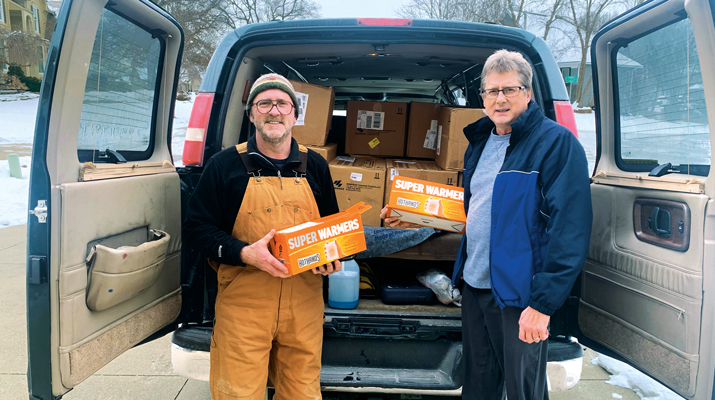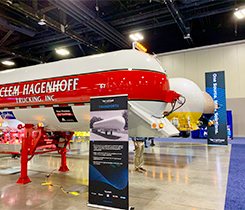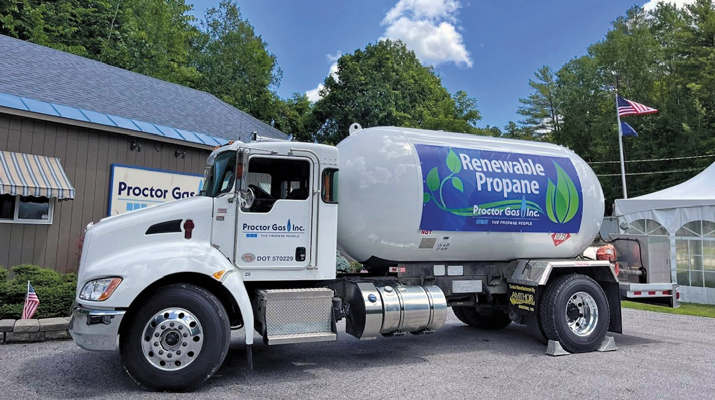It’s Show Time!
Today, you’re going to walk miles and miles of aisles and aisles, shake hands with 4,000 people, and listen to 350 sales presentations. This is not your typical day at the office – unless you’re heading for Atlanta and the 53rd annual National Propane Gas Association Southeastern Convention & International Propane Expo.
A day at the Southeastern show can be exhausting, chaotic, and mind-boggling. Or it can be exhilarating, profitable and informative. Like any other day at work, the results depend largely on your attitude and actions. The producers of the show think you’ll find it worthwhile.
“This is a family reunion that’s been going on for over 50 years,” according to Chuck Brandon, director of field services for NPGA’s southeastern district. “It started with 1,200 attendees visiting 90 booths on a 40,000-square-foot show floor. This year there will be 3,500 to 4,000 people, 350 exhibitors, and a 280,000-square-foot hall. Even with all this growth, we hope we’ve been able to keep the ‘family reunion’ feel.”
Why are you going?
Seeing vendors and their product lines is almost always the number one reason to attend any trade show, but your goal should be a little more specific than just “seeing suppliers.” Decide whom you’re going to see and whether you will do any actual buying at the show or just gather information for future orders.
“About 85 percent of our exhibitors have been showing here for more than 10 years,” says Brandon. “We get great attendance because we have super exhibitors, and we have super exhibitors because we have great attendance.”
Another reason to attend is to keep up with industry developments and market trends. Specificity is the key to maximum productivity. You shouldn’t go just to “see what’s happening.” Is there a new product category emerging? Are companies in other parts of the country doing things differently? You’ll have your own ideas about which areas to pursue, but also ask your staff if there’s something they want you to look into while you’re there.
You can gather information from product demonstrations, chatting with vendors and suppliers, or setting aside some time to improve your business or technical skills at one of the three educational seminars being offered. Some of the other goals you may want to set include finding potential employees, strengthening vendor or customer relationships, or exploring partnerships, investment opportunities, or even the sale of your business.
Choosing your specific goals will lead naturally into a list of questions to ask at the show. Write them down! It may seem unnecessary, but having a written list will be invaluable in the hubbub on the show floor.
What are your priorities?
Once your goals are determined, draw up a plan of attack. Budgeting your time like this in advance may seem like overkill, but keep in mind that there are a tremendous number of things to see and people to talk to. Brandon points out, for example, “We will have more than 40 trucks on display this year, everything from 18-wheelers to cranes to bobtails.” And that’s just one product category. The show floor is open 15 1/2 hours. If you tried to visit every exhibit, you’d have to stop at one every 2.7 minutes. So, with the show schedule and exhibitor list in hand, make a list of “Must See” and “Like To See” exhibits.
 |
Then allot some time to each one. A visit to a supplier to negotiate a deal could probably take 20 minutes. If you are going to comparison shop that vendor’s competition, allow the same for each one. For information-only visits, count on half that amount depending on how many questions you have on your list. You also need to set aside some time (about 35 percent) for unexpected opportunities, travel between your hotel and the Georgia World Congress Center, as well as lunch and other breaks.
Make appointments
The final time-management step before leaving for the show is the one most trade show attendees ignore-making appointments. Call every “Must Have” exhibitor and set a specific time to meet for the appropriate 10 or 20 minutes. Set these meetings so you leave the first and last exhibit hours open each day (see below). Since the show covers more than six acres, you’ll probably want to group your meetings geographically so have the exhibit hall maps in hand when you make the calls.
Why should you go to this trouble? Because it puts you in control of your time. Assuming you spend three nights in Atlanta, your investment in hotels, airfare and other travel expenses can total more than $1,000. That means every one of the 15 1/2 hours on the floor costs $65 – not including the value of your time. How much time-at a dollar a minute-do you want to spend waiting around a booth for a sales rep? Having a schedule to follow also keeps you more focused on the business at hand.
Show time
Your badge is pinned on and through the doors you go, ears and eyes open, notepad at the ready.
When you made your appointments, you kept the first and last hours of the exhibit day open. Those hours are the ones when traffic is lightest, so you can get to more exhibits and receive more attention when you get there. It’s a good time to see people you couldn’t get appointments with or to explore some of the “Like To See” exhibits.
When you enter an exhibit, it’s important to manage the conversation. You don’t have to be rude, but minimize the small talk in the interest of time. If the sales rep starts a pitch about something unrelated to your needs, cut it off with one of your questions. What if the person you want to see is talking to someone else? Use a polite elbow (figuratively speaking) by standing near enough to overhear them. At an appropriate opening, tell them that you’re interested in the same thing they’re discussing and ask a question. Most of the time, the first person will wrap up his business quickly and leave the exhibitor to you. If someone tries to cut in on you, by the way, just keep focused and make sure your questions get answered first.
Your overriding goal is to get information, but that doesn’t mean you need to carry tons of it around with you. Every exhibitor will try to press literature into your hands. Don’t take it unless it’s really important to you now. Instead, ask the rep to send it to you after the show. Keep that tactic in mind while you’re standing in line to get that logo-imprinted combination screwdriver-bolt-cutter-juice-squeezer, too. Do you want to carry that around with you all day?
Many times, you’ll ask a question the exhibitor can’t answer and he or she will promise to get back to you with the information after the show. To make sure he or she does, write your question on your business card and give it to the rep. Do the same with his or her card when you get it. Now there’s no excuse for either one of you to forget to follow up later. You can also get the names of the engineer and technician the exhibitor is going to ask-then call them yourself.
Workshops and networking
Some of the most productive time you’ll spend in Atlanta will be in the seminar area. That’s where the crucial issues facing the propane industry will be addressed and discussed. This year, one of the key sessions will deal with the problems of insurance rates and availability. A special seminar, “Insurance Today – Where Will It Be Tomorrow?” is scheduled for Monday, March 31. Paul Lindsey Jr., NPGA vice chairman and president of All-Star Gas in Lebanon, Mo., chaired a special task force that will discuss the issue.
If you attend a workshop, take a checklist of questions-then ask them at the first opportunity. Assuming you have time at the end of the presentation, move to the speaker’s vicinity and listen to others’ questions-or ask your own.
Seminar leaders don’t have a monopoly on useful information. Your peers (the other 3,999 attendees) face the same issues you do. John Taylor, president of Taylor Gas, says, “You might have dinner with someone from the other side of the globe that has the same problem you do, but he’s already figured out how to solve it – that’s invaluable.” Networking opportunities include everything from scheduled social events to shuttle bus rides. “My advice is to take notes, shake hands, look people in the eye and remember them,” Taylor continues. “The people in this business stay in this business and you need to get to know them. Don’t talk – listen.”
At the end of the day you should have a pocket bulging with business cards and a pad full of notes. Take a few moments to review them to see if there’s anything that needs follow-up while you’re at the show. You might want to highlight items you need to address when you get home. It’s easier to decipher your notes while they’re fresh in your mind. Some people also code the business cards they’ve picked up, marking them as vendors, prospects, or competitors.
The show doesn’t end when you head for Hartsfield International Airport or Interstate 75/85. There are four things you should do as soon as you get back. First, confirm in writing any deals that you made during the show. The rep may have a fantastic memory, but details tend to get lost. Second, brief your staff on what you learned at the show. Third, update your contact files with all those business cards. Finally, do an honest post mortem to determine whether the time, effort, and money you just invested will give you an adequate return. Did you accomplish your goals? Is there anything you’ll do differently next year?
Then start packing for the 2004 show.
You may feel like a trout when you walk into the Georgia World Congress Center this spring. That’s perfectly normal because hundreds of companies are angling to hook your checkbook at the NPGA Southeastern Convention and International Exposition in Atlanta.
 |
“There’s just a world of buying, selling, trading, and entertaining,” according to Al Darr, director of corporate development for Heritage Propane Partners. “If an independent retailer has need of anything, they’ll find it here. There’s just no place else where you can see so many products and services in one place at one time.”
All those vendors are there to sell but, then, you’re probably there intending to buy-and guess which end of the fishing line has the advantage? If you know what those sellers are thinking and what they’re going to do next, you’ll be a much more effective buyer.
Here’s a look at what’s going on in the sales rep’s head and some tips on how you can bring home the best deals. Several factors affect the process, most of which give you an edge.
Trade show buying factors
Time is a big factor for both the buyer and the seller. The sales rep wants to sell as much as possible in the 15-plus hours the exhibit space is open. You have a little more flexibility in your schedule, but you don’t have time to play “hard to get.” This is a good negotiating ploy normally, but is generally a waste of time at an expo. If you intend to be a buyer, say so.
Information and who has it is another factor. You know how big an order you expect to place, but the rep doesn’t. You know what the competition has offered; the rep doesn’t. It’s the seller’s job to pry this information out of you and, to serve your own ends, you’ll probably give some of it up – but you control the flow.
Then there’s the turf factor. The convention hall lobbies, restaurants and aisles are yours. When you step into an exhibit, though, you’re on the seller’s turf. And they’ll go to great lengths to get you there.
Last year, for example, Trinity Industries’ exhibit featured the Budweiser Girls and Dale Earnhardt Jr.’s NASCAR racer.
Buy-sell transaction stages
The first thing the typical salesperson will do is try to qualify you. The time factor is at work here, since the seller wants to deal only with those prospects who intend to buy today. You will be asked a few questions to determine whether you are a tourist, a tire-kicker, or a buyer.
A tourist is just passing through. When asked if they need some help, a tourist will say, “No thanks – just looking,” or something to that effect. Unless you want to waste time tracking down a sales person later, avoid these types of phrases.
A tire kicker is someone who won’t buy right now but may in the future. A rep will want to spend only as much time as it takes to get contact information for future follow-up and hand you a brochure. You, on the other hand, probably want some more specific information, so keep the salesperson’s attention by asking plenty of questions.
If you’re a buyer, the salesperson will want to know several things about you beginning with whether you are the final decision maker or a decision influencer who will make recommendations to someone else. If you’re really there to buy, get right down to business.
“People in this industry generally don’t need an education about most products, so they don’t waste a lot of time,” says Tom Aikens, Trinity’s vice president of sales.
What do you need?
Among other things, the rep should try to determine your needs for their product line. Is it replacing an existing line or are you restocking? Do you want to upgrade to a higher price point? In other words, what are you trying to accomplish by making this purchase?
The seller will also want to know the potential size of your order, of course, as well as when you intend to place it. A good salesperson will probe to find your “hot buttons,” or the criteria like price, delivery date, terms, etc., that you will use to make a decision.
The temptation is great to play games during this stage – to withhold information or play hard-to-get. But the best way to find out if they can satisfy your needs is to be very specific and truthful about what you’re looking for and why you want it. The only factor you might fudge on is the order size because you may be offered better terms if the rep thinks you’re going to place a monster order.
The third stage comes when the seller starts pitching his line. Unfortunately, too many reps have been trained to push their company’s newest product regardless of what the customer actually needs. This can be a huge time-waster, so don’t hesitate to interrupt and focus on your needs. It’s your money on the table so you’re in charge.
When the seller offers a product you like, be straightforward about any obstacles to the sale. Don’t offer objections just for the sake of objecting. Instead, make sure you’re very clear about what information you still need.
Aikens says, “We have enough people on hand at any given time so we can give the customers as much time as they feel they need.”
Here comes the hook
The seller at some point will ask for the order. This isn’t the end of the buy-sell process, but it’s the beginning of the end. If you have all the product information you need, it’s time to enter the negotiation stage.
One of the great advantages of buying at shows like the Southeastern Convention is the huge number of vendors to choose from-about 350 this year. Any given product category will probably have dozens of suppliers competing for your business. Ask the rep who’s trying to close you for the offer in writing, and then go see his competitors. That way you know you’re comparing apples to apples and he knows he’d better offer you the best price right now – otherwise,you might not be back.
Once you’ve done your comparison shopping, go to the supplier you’ve chosen and place the order. Begin by asking the rep if his previous offer is as good as he can do. Try to take up some more of the seller’s time, since the more of it is invested in you, the greater the urge to close the sale.
Finally, make an offer you’d be comfortable accepting (not a ridiculously low one – that could blow the work you’ve done) and offer to place the order right now. You’ll be surprised how often your offer is accepted. And the worst that can happen is you get the original deal, which your shopping has shown to be the best anyway.
Trade shows and expos are great places to make good deals. You can shop among dozens of competing vendors, see new equipment and supplies, watch product demos, and do hands-on testing. Who knows, you may even pick up a free T-shirt to go with the great deal you got by knowing your sellers’ secrets.
















